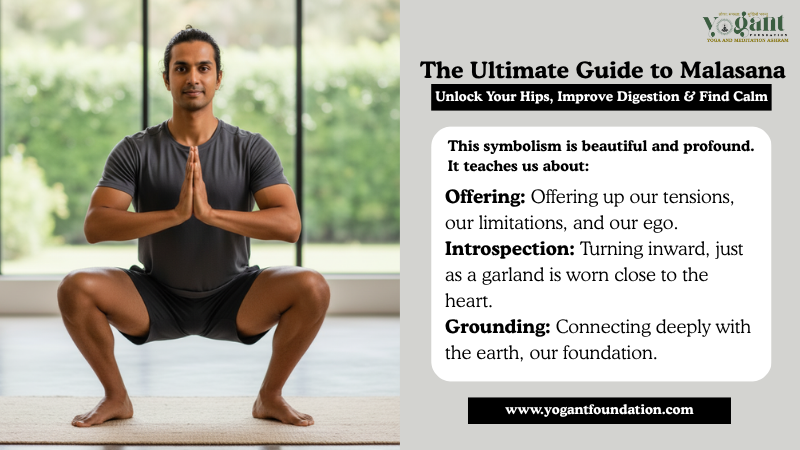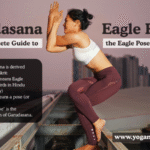Introduction: More Than Just a Squat
Be honest. In our modern world, where chairs are everywhere, how many people can relax in a deep squat? [Malasana]
You’re not the only one who feels their knees tremble and lower back grunt at just thinking about it. Many people associate the deep squat with childhood and a less mobile time. What if you were told that this basic human position could have a profound impact on your health and mental clarity, as well as your digestive system, when you reclaim it?
Welcome to Malasana, or Garland pose. Malasana offers much more than a simple “yoga squat.” It is an empowering, holistic pose that unlocks tension and helps you build strength.
This comprehensive guide will take you deep inside Malasana. This comprehensive guide will explore the rich symbolism of this pose, dissect its anatomy, and give a detailed step-by-step instruction for all levels, from beginners to experienced practitioners. Discover the benefits of this pose and how to overcome the challenges we all face.
Take a deep breathe and begin your journey to becoming a grounded, more open, and stronger you.
What is Malasana? Unpacking the Garland Pose
Let’s first understand “what” before we move on to “how.” Malasana, a foundational pose of hatha yoga. Named after the Sanskrit ” Asana ” and ” mala,” which mean “garland or necklace” respectively.
The Symbolism Behind the Pose
This pose is reminiscent of a long string of flower garlands draped around a circle. Flower garlands, or malas (traditionally called ‘bangles’), are used to show respect and devotion in traditional practice. In Malasana, your torso is positioned between your legs, and you can either draw your arms in prayer to your heart or around your shins. This creates a circular garland.
This symbolism has a profound and beautiful meaning. It is a beautiful symbol that teaches about:
- Offering: Giving up our tensions and limitations.
- Introspection: Looking inwards, as one would wear a garter close to their heart.
- Grounding: “Connecting deeply with earth” as our foundation.
This pose humbles you, reminds you of your inner self, and brings back the simplicity of human design.
Why Your Body Is Craving: The Incredible Malasana Benefits

Our days are spent slouching over our screens and moving only in predictable patterns. Malasana offers the cure. This is a complete system reset with a wide range of benefits.
1. The Ultimate Hip Opener
If you only do one thing to improve your hips, it should be Malasana. This posture provides a sustained, deep stretch for:
- Adductors (inner thighs)
- Buttocks (buttocks muscles)
- Hip flexors (the group of muscles in the front of your hips)
Release tension in this area to relieve lower back pain and improve pelvic circulation. You can also restore your natural, graceful walk.
2. Ankle and Foot Mobility Masterclass
Our feet and ankles are stiffened and weakened by modern, restricted footwear. Malasana requires and develops full ankle dorsiflexion. It is important for walking, running, and maintaining our balance.
3. A Digestive Powerhouse
One of the benefits of Malasana is that it helps to improve digestion. In the squat, the deep compression on the abdominal muscles acts like a gentle internal massage. This exercise stimulates your digestive fire, or “Agni”, in Ayurveda. It can relieve constipation and promote healthy elimination. Imagine it as a daily tuning-up of your digestive system.
4. Strengthens Your Entire Lower Body
Do not be fooled by the appearance of “stretchy”. The Malasana is an excellent strength builder. It actively engages your:
- Quadriceps (front of thighs)
- Calves
- Core muscles that keep you upright
This is a compound, functional movement that builds a powerful and resilient lower body.
5. Prepares for Childbirth
Malasana, when performed by pregnancy women (under the supervision of a prenatal yoga instructor who is experienced and has the approval of a physician), is sometimes called “the midwife’s position.” This posture can help to create more room for your baby’s descent by opening the pelvis.
6. A Pose of Mental Calm and Grounding
Being low to the ground is calming. Malasana helps to ground you. This pose can calm a busy brain, reduce anxiety, and give a feeling of security and stability. This form can make you feel at home when the world is chaotic.
The Anatomy of a Perfect Malasana: A Step-by-Step Guide
Are you ready to try it? We’ll break it down so that you can safely practice.
Step 1: The Starting Stance
Start by standing slightly wider apart than your hip width. Your toes should be at a 45-degree angle. Listen to your body. There is no “one size fits all” here. You should align your heels with the outside edges of your hips.
Step 2: The Descent
As if aiming for a low-seated chair, bend your knees. Lower your hips back and down. Imagine creating space between your vertebrae. Don’t round your back. For now, it’s okay if your heels lift off the ground. Later, we’ll talk about that.
Step 3: Finding Your Alignment
- Knees: Move your legs in the direction of your toes. Do not let your knees collapse inward.
- Spine: Lift your chest and keep your spine straight. Do not round your upper back. Consider shining your heart outward.
- Hips: You should have hips that are low and preferably below your level.
Step 4: The Arm Variations
Here is the place where you can create your garland.
- Classic Prayer (Anjali Mudra): Place your hands together in the center of your chest. You can gently separate your legs by using your elbows. This will create a beautiful opening at the hips.
- Looping The Garland: Place your hands inside of your knees and press your elbows into your inner thighs while bringing your palms close together. It gives you more power to move your hips.
- Hands on the Floor: When balance is a problem, you can place both hands on the ground in front of yourself to provide support. It’s a great and valid variant!
Step 5: The Breath
Take 5-10 slow, deep breaths. Feel your spine expand with each inhale. Feel your hips drop a bit deeper with each exhale.
“But I Can’t Do Malasana!” – Your Modification Toolkit
The most important part is this. For most Westerners, the full expression of Malasana should be a target and not just a place to start. You should respect where you are right now. Intelligent modification, not forcing the pose, leads to improvement.
Modification 1: Heel Support
Challenge: Lift your heels off the ground
Solution: Put a blanket folded, a mat of yoga mat, or an adapted wedge for yoga under your heels. It is THE SINGLE MOST EFFECTIVE modification to Malasana. This modification compensates for limited foot mobility and lets you focus on hip opening while maintaining your balance.
Modification 2: Width and Angle
Challenge: You feel your knees are strained or that your inner thighs may be too tight.
Solution: Adjust the angle of your foot and widen your stance. The wider the base, the more room you have for your torso. It also reduces the depth and makes the squat more accessible.
Modification 3: The Chair Squat
Challenge: It’s impossible to get low without a round back.
The solution: Seated on the edge of the chair, feet flat on the floor, and knees bent. Lean your body forward, while keeping your spine straight. It teaches you the action for the upper body of Malasana, without the depth.
Modification 4: The Supported Squat
Challenge: Balancing.
Solution: Face the wall with your back. Placing a book or yoga block between your legs will work. You can use the block and wall as seats while squatting. It builds strength and confidence.
Weaving Malasana into the Fabric of Your Life
Malasana is not limited to the yoga mat. When it is a regular part of daily movements, its true power will be revealed.
Malasana In Your Yoga Practice:
- As a warm-up: Try a few rounds in and around Malasana to get your knees, ankles and hips ready for the practice.
- Aa Counter Pose: After deep backbends such as Wheel Pose, Urdhva Dhanurasana, to relieve compression of the lower back.
- As a Transition: Use it to transition from Malasana or as a strong, grounding starting point for Chaturanga.
In Your Daily Routine:
- 30-second rule: You can’t hold Malasana long. That’s fine. Hold it just for 30 seconds every day. You can do it while you wait for the kettle or brush your teeth. Consistency trumps duration.
- Replacing Your Chair: Not all the time. Can you sit in a supported squat for 5-10 minutes per day while watching TV or playing with the kids, reading, or listening to music? The “passive” stretch is extremely effective.
- Play and Gardening: Next time you have to lift something from the ground or in the garden, drop into Malasana rather than hunching at the waist. You’ll thank your back.
Beyond the Physical: The Energetics of Malasana
Chakras, in yogic philosophy are centers of energy that exist within the body. Malasana can have a significant impact on the two first chakras.
- The Root Chakra (Muladhara): At the base of our spine is the Root Chakra, or Muladhara. This energy center controls the sense of security and safety. The Malasana position, which is low on the floor, stimulates this chakra and helps to ground it. This can calm your fears and give you a sense of security.
- The Sacral Chakra (Svadhisthana): This center, located in the lower abdomen, is associated with creativity, emotion, and pleasure. The deep hip opener Malasana helps release emotional tension.
By focusing on this, you can turn this exercise from one of physical fitness into an active meditation for creativity and balance.
Frequently Asked Questions About Malasana
Q: My knees hurt in Malasana. What should I do?
A: Knee pain should be a warning sign. First, make sure your knees do not collapse inward. Use a heel support blanket to decrease the angle of the knee. Third, don’t go as deep. Respect your limits. Consult a yoga instructor or physical therapist if pain continues.
Q: Is it bad if my heels don’t touch the ground?
A: Not at all! This is a common sign that your calves are tight or that you have limited mobility in the ankles. The heel modification should be used religiously. With consistent practice, you’ll see that your heels will get closer to the ground over time.
Q: How long should I hold Malasana?
A: Start by holding for 20-30seconds. Working your way up, hold the position for 1 to 2 minutes. To get the most out of this pose, you need to take deep breaths and let go.
Q: Can I do Malasana if I’m pregnant?
A: It’s important to seek your doctor’s approval before practicing Malasana during pregnancy. If you notice that your abdomen has changed, make sure to adjust your position. Pay attention to what your body is telling you.
Conclusion: Your Journey Back to the Squat Starts Now Malasana
Malasana means more than a simple pose. The pose invites you to return to your original state. This is an exercise in patience and self-compassion. It’s a great tool to improve your physical and mental well-being.
Malasana will only work for you if it is something that appeals to you. All that matters is you start. It’s important to start. Take your mat out, cover your heels with a towel, and then take your first conscious downward step. Face your body, breath into it, and let the experience guide you.
One squat will lead you to an open hip, a relaxed mind, and a strong body.



